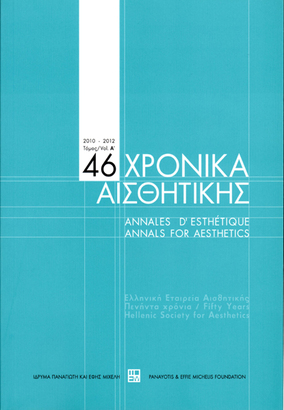Κωνσταντίνος Παπαδημητρίου : ο αγραφιώτης τεχνίτης του Πηλίου
Part of : Χρονικά αισθητικής : ετήσιον δελτίον της Ελληνικής Εταιρείας Αισθητικής ; Vol.27-28, No.1, 1988, pages 79-103
Issue:
Pages:
79-103
Parallel Title:
C. Papadimitriou and his artistic activity in the Pelion area (Thessaly)
Author:
Abstract:
The author publishes a sculpture, unknown to the research work of the Neohellenic wood-carving of the 19th cent, which belonged to the private collection of the late Effie Michelis.The statuette which depicts Karai'skakis, a well known hero of the Independence War against the Turks (he died after the battle of Phale- ron in 1827), is attributed on the base of stylistic and epigraphical evidence to Constantine Papadimitriou, who originated from the village of Vraha, located in the mountainous Agrapha area, but as many of his contemporary artists did, moved and acted as a sculptor as well as a painter in the mountain Pelion area (Thessaly).The statuette is connected artistically with a unique group of similar wooden and painted statuettes which must have formed part of a contemporary order and belong to the National Gallery, the Historical Museum (Athens) and the private collection of the late K. Makris (Volos). They are almost all —except one which belongs to a group of two— represented as independent figures in a bold manner.The author traces the artistic activity of Papadimitriou within a period of 14 years (1829-1843). As closest comparative material for discussion are brought a) the prowfigures which are also worked out as almost free standing figures and b) some miniature figures which are sculpted equally almost in the round and belong to church screens from the same area.Papadimitriou, following the local tradition, depicts the hero of the Michelis statuette as an every day individual of his own area and time, dressed in the traditional way, wearing his complete armour (whose details are stressed in the most remarkable way). Papadimitriou never used a model (the wooden figures of the Papadimitriou group have nothing to do with the personal features of the heroes represented as those have been put down by academic painters (like Krazeisen and Peter von Hess) and most probably whatever he knows about Karaï- skakis must have reached him throught oral tradition and folk-songs which, it seems, were sung and rapidly spread all over the country.
Subject:
Notes:
Αφιερώνεται στη μνήμη της Έφης Μιχελή, Περιέχει εικόνες




